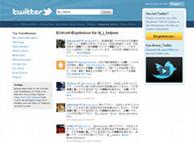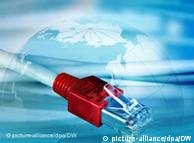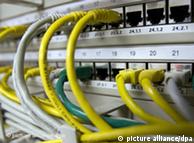INTERNET | 18.03.2011
Japan's communications network weathers quake largely intact
The magnitude 9.0 earthquake that rocked Japan last Friday damaged some undersea data cables, but caused surprisingly few disruptions to the country's Internet and telephone network, according to representatives of the country's telecom industry.
Pacific Crossing, a subsidiary of the Japanese telecom giant, NTT, reported on its website that its PC-1 West undersea cable, connecting the southern Japanese city of Shima with Ajigaura, 136 kilometers north of Tokyo, was severed.
Pacific Cable's PC-1 North cable, which runs from Ajigaura to Harbour Pointe near Seattle on the United States West Coast, was also severed.
Vulnerable bottlenecks Many Japanese have turned to Twitter for information about the quake
Many Japanese have turned to Twitter for information about the quake
 Many Japanese have turned to Twitter for information about the quake
Many Japanese have turned to Twitter for information about the quakeWhile it may often seem like the Internet is a vast, borderless network, in reality it relies on a series of fiber optic cables that are encased to protect against earthquakes, shipping traffic, and marine life.
Sometimes damaged cables, particularly at certain bottlenecks, can lead to service outages in some parts of the world. Most recently in Asia, the December 2006 earthquake in Taiwan disrupted Internet service across the region for several weeks.
"We are trying to restore capacity right now," said Koji Kimura, a Pacific Crossing spokesperson, in an interview with Deutsche Welle. "[Those cables] are no longer in use, but unfortunately the cable was physically cut due to the tsunami wave - half of our capacity is down."
The company also has an additional cable that runs down the west coast of the United States, from Harbour Pointe, to Grover Beach in California, which is known as PC-1 East, and an additional cable that runs from California back to southern Japan, known as PC-1 South.
Kimura said the diversion had not affected most customers' level of service on the whole.
In a statement, the company said it expected its northern and western cables to be repaired by March 29 and April 19 respectively.
However, this schedule could yet be "subject to change due to radiation levels" at the Fukushima plant in the area of the company's cable faults.
Further damage
Another Japanese telecom company, KDDI, the country's second-largest telecom provider, also reported that the Japan-US cable, a major undersea cable connecting Shima with California had been damaged.
"That cable was broken but we have another backup cable so that we are still providing services continuously," said Satoporu Ito, a KDDI spokesperson, in an interview with Deutsche Welle.
The company said it would send out a ship with diving robots to repair the cable. However, that could take months, Ito said, as the company does not yet know exactly where the damage occurred.
KDDI is currently partially re-routing some of its traffic through the Russia-Japan cable network, which connects Japan's western coast with a Russian landing station outside of Vladivostok, just north of Japan.
"There is no difference between this backup cable and the one we were using usually, there is no [difference] to the customers," Ito said.
Taiwan's leading telecom operator, Chunghwa Telecom, also confirmed that the Japan-US and the APCN-2 cable were damaged. The latter cable connects Japan, China, Taiwan, Singapore, Malaysia and the Philippines.
Chen Hui-yen, a company manager, told the Agence France Presse on Wednesday that company bandwidth capacity had been reduced by 30 percent, noting that it could take over a month to repair the rupture.
"There were impacts, but they were limited," she said. "As of now we have received few complaints from customers."
 Telecom industry experts are impressed with the Japanese network's resilienceAmazon's Japan data center unaffected
Telecom industry experts are impressed with the Japanese network's resilienceAmazon's Japan data center unaffectedTelecom industry analysts said it was still too early to say how badly the region's undersea cables were damaged.
"My colleagues are in the process to analyze the situation in Japan after the massive earthquake and subsequent tsunami in the areas interested," wrote Cristina Bardelli, a spokesperson with the German telecom industry analysis firm InfoCom, in an e-mail sent to Deutsche Welle.
She added that in the immediate aftermath of the quake, mobile phone service in eastern Japan was either overloaded or damaged, but that overall, Japan's telecom companies were able to respond "very quickly." She said Japan's infrastructure was "very stable," composed of "good technology" and of "strong quality."
"As far as we can judge, the fixed infrastructure was less damaged than the mobile one," she said, adding that it was not yet possible to provide percentage figures of the extent of the damage as "the information from the Japanese side is very careful."
"But connection to the Internet appeared virtually unaffected. Amazon Web services had just opened a data center, which apparently is running normally. We have information that some carriers providing broadband access have open their networks, for instance Softbank, and people can connect to the internet through WiFi hotspot free of charge."
Last Friday (March 11), James Cowie, the CTO of the American Internet analysis firm Renesys, posted on a company blog that Japanese Internet connectivity had "survived this event better than anyone would have expected."
"The engineers who built Japan's Internet created a dense web of domestic and international connectivity that is among the richest and most diverse on earth, as befits a critical gateway for global connectivity in and out of East Asia," he wrote.
Author: Cyrus Farivar
Editor: Nathan Witkop
Editor: Nathan Witkop
dw

Comments